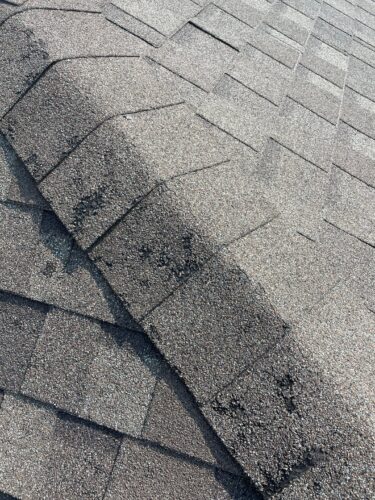We get it – you’ve just got that pristine new roof, and there’s a nagging voice in your head daring you to put a hole in it. And, despite your better judgment, that voice often wins. Maybe you’re contemplating some ‘speed holes’ to make your roof look faster? Or perhaps you’re just feeling a bit…holey?
All jokes aside, here at Whalley’s Four Seasons Roofing, we’re experts at making holes in roofs or doing roof repair and doing it right. Need a skylight? That’s a hole. How about a vent for your attic? Another hole. Got a Starlink cable or other satellite connections? Yep, you guessed it – that’s a hole too. Making holes in roofs is our bread and butter, but it’s not just about creating an opening; it’s about what goes into it.
Think you don’t have holes in your roof? Think again. All those vents, pipes, and even nails – they all create holes. But before you start feeling like Swiss cheese, let’s clear something up. It’s not about avoiding holes altogether; it’s about making the right holes in the right places and making sure they’re done well. That nail in your shingle? It’s a tiny hole, but how it’s handled makes all the difference.
So, let’s dive into the world of roof holes for residential roofing – the good, the bad, and the leaky – and see how making the right ones (and sealing them properly with a professional roofing contractor) is key to a healthy roof. And hey, if you’re feeling extra holy this year, let’s make sure those roof holes are done right.
The Art of Hole Making (Avoiding Damage)
If Subway employees are called sandwich artists, then we can be called “Roofing Maestros.” Now before you get that pickaxe, chainsaw, or whatever weird invention you want to try out on your roofing project, remember: you shouldn’t be making holes willy-nilly. Each hole in your roof needs to be a symphony of precision and waterproof seal, not a freestyle jazz session.

Here are a guide to the top reasons to make a hole in your roof:
- To Secure Your Shingles (Yes, Nails Count): Every nail is a small hole, but it’s a necessary evil. These tiny punctures, when done correctly, keep your shingles firmly in place, fighting against the wrath of Mother Nature.
- Ventilation (The Most Overlooked and Critical, Especially in Winter): Proper roof ventilation is the unsung hero of roof longevity. It prevents moisture build-up, regulates temperature, and keeps your attic from turning into an unwanted sauna or icebox. Without proper airflow, your roof can suffer from mold, ice dams, and structural damage.
- Skylights (Let There Be Light): Who doesn’t love a bit of natural light? Skylights are like the sunroof of your home, offering not just light but also a touch of elegance. But it’s not just about cutting a hole and popping in a window; it’s about strategic placement and expert installation to avoid roof leaks and future repairs.
- Plumbing and Electrical Vents (The Functional Holes): These holes might not be glamorous, but they’re essential. Plumbing vents help regulate air pressure in your pipes, while electrical conduits keep your home’s wiring safe and dry. Installed improperly, they can cause roof damage or compromise your insulation.
- Satellite Dishes or Solar Panels (The Tech-Savvy Holes): Embracing modern technology means you might need to install equipment like a Starlink satellite or rooftop solar system. These systems require anchoring to your roof, which means punctures – but done right, they won’t lead to leaks or costly repairs.
In the world of roofing, making a hole is an art and a science. It’s not just about the action of cutting through shingles and plywood; it’s about understanding the purpose behind each hole and executing it with precision. So, the next time you look at your roof, remember, it’s not just a shelter; it’s a canvas of functionality, each hole playing its part in the greater masterpiece of your home.
A Hole Lot of Options: Skylights, Vents, and More
So, now you know why we need these holes, but what’s the difference between a bad hole and a good hole when it comes to things like nails, skylights, and vents? Well, it’s all about placement and flashing.

Roofing Nail placement is crucial
Depending on the roofing material and manufacturer, the approach to using nails during installation can vary. If you’re tackling a DIY project and your friend suggests a “better way” than what’s recommended, exercise caution. It’s usually best to stick to the packaging instructions. However, for standard shingled roofs, there are some general rules to follow.
Nails should not be visible on a properly installed roof in most instances. When we install shingles, it’s all about creating the right overlap, which is why we work from the bottom up in a diagonal manner. Each time a nail is placed, it’s overlapped by a subsequent shingle. This method ensures that when water sheds off the roof, it should never be in constant contact with the nails.
Even a small hole caused by an exposed or misplaced nail can allow water in if not sealed properly. If you do see nails on your roof, it’s a sign of improper installation. Exposed nails are prone to rusting, and over time, they can leave holes – the bad kind that we want to avoid. Correct nail placement is more than just aesthetic; it’s a fundamental part of ensuring the longevity and integrity of your roof.
Why Flashing is Essential
Flashing is typically made from materials like aluminum or galvanized steel and is designed to direct water away from critical areas of your roof, such as around skylights, vents, and chimneys. Without proper flashing, these areas are prone to leaks, which can lead to significant damage over time.
Types of Flashing for Different Roof Features
- Skylights
Skylight flashing is customized to fit around the frame of the skylight, creating a watertight seal between the roof and the window. - Vents and Pipe Penetrations
Vent flashing is designed to surround roof vents, plumbing stacks, and exhaust fans—sealing the area where they pass through the roof. - Chimneys
Chimney flashing uses a combination of step flashing and counter flashing to create a layered, water-resistant barrier at one of the most leak-prone parts of your roof. - Roof Valleys
These low points, where two roof planes meet, collect water during rain or snowmelt and must be flashed with metal valley flashing to direct it safely off the roof. - Dormers and Sidewalls
Where roof meets vertical siding, step flashing ensures water sheds off each shingle properly without getting trapped at the transition. - Drip Edges
Installed along the eaves and rakes, drip edge flashing prevents water from wicking up under shingles and damaging your roof deck. - Headwalls and Wall Junctions
Where the roof meets a vertical wall at the top (like a garage or addition), continuous flashing prevents rain from slipping behind siding and entering the home.
Installation and Maintenance
The installation of flashing is a delicate process that requires precision and expertise. It’s not just about placing the material; it’s about ensuring it seamlessly integrates with the edge of your roofing material and the feature it’s protecting. Regular inspection and maintenance of flashing are just as crucial to prevent deterioration and ensure ongoing effectiveness.
In essence, while the holes we make in roofs are necessary for various functionalities, flashing is what keeps these holes from becoming a homeowner’s nightmare. It’s the difference between a well-functioning roof feature and an unintended indoor waterfall leading to extensive damage.

Goop Them Up: The Role of Sealants in Roofing Patch up
When it comes to nails, fasteners, or any exposed elements on the roof, it’s essential to talk about sealants – commonly referred to in the industry as ‘roofing goop.’ The specific type of sealant we use varies based on its location and purpose.
Choosing the Right Sealant
It’s important to note that while sealants are essential in roofing, they must be used correctly. Overuse or improper application can lead to issues down the line. Typically, we use sealants in critical areas such as around vents and fittings, where there are usually three nails or fasteners. Without a layer of sealant, these fasteners are prone to rusting and further damage, eventually causing leaks.
Application and Maintenance
Sealants are primarily used to prevent water infiltration around small openings or joints. In the case of vents or other similar installations, a bead of sealant ensures that the point where the fastener penetrates the roof remains watertight. However, it’s essential to monitor these areas regularly. The sealant can degrade over time due to exposure to the elements, long before your roof itself fails. Regular checks can help identify when reapplication is necessary to maintain the integrity of the seal.
It’s also worth mentioning that the choice of sealant depends on the roofing material and the specific environmental conditions. A sealant that works well on a traditional shingle roof might not be suitable for a metal roof, and vice versa.
In conclusion, while sealants (or ‘roofing goop’) play a critical role in protecting your roof, they are not a cure-all solution. Proper application, regular maintenance, and using the right product for the job are key to ensuring these sealants do their job effectively.
Should You DIY a Roof Hole or Roof Repair or get Help?
We get the appeal. With the right tools, enough prep, and a bit of confidence, some folks can pull off a decent roof penetration or patch. If you’re the kind of person who does their homework and understands what’s at stake, you might be up to the task.
That said, even with the best intentions, a small mistake can lead to big problems. One misstep—like skipping a layer of flashing or using the wrong sealant—can result in hidden water damage, mold, or costly repairs down the road. We’ve seen it happen more than once.
Know how tips plus Tools and Materials Needed
sometimes you can hack something together with what you have but there is a saying that nothing beats the right tool for the job, and each proper tool and technique goes along way. Everything from a ladder, claw hammer, roofing tar, ceiling cement, utility knife, liquid nails, tar paper, and knowledge on rafter replacement just to name some could be needed. Tips online might offer other solutions bet when following there step guide there might be cracks literally and figurative in there process when it comes to your situation.
Is it worth it to do DIY?
We don’t say “don’t DIY” just to keep the work for ourselves. It’s more about protecting your home and covering our bases. Roofing is about more than just shingles, nails and even screws. It’s a system ,a step process, with every cut, nail, and seal affecting how that system handles water, wind, and weather.
That matters even more in Calgary. Between the freeze-thaw cycles, hailstorms, and dry-to-humid swings, our roofs take a beating that sometimes require new decking by replacing plywood. Not every tutorial accounts for that. We’ve learned through years of hands-on experience which products hold up here, which techniques work better in this climate, and which ones look fine at first but fail after a season or two.
If you’re sure of your plan and willing to take the time, go for it. Just know what’s involved. If anything feels off, we’re here to help. Sometimes that means answering your questions. Other times, it means stepping in to get the job done right.
You don’t need to be afraid of putting a hole in your roof. But you should be thoughtful about how it’s done—and who does it.
Final Thoughts on Roof Holes and Maintenance
The truth is, holes in your roof aren’t a problem—badly made ones are. When they’re placed right, sealed properly, and inspected once in a while, you’ve got nothing to worry about.
So keep your roof, and your home, solid and secure by leaving it to the roofing experts here at W4SR (Whalley’s Four Seasons Roofing). We are professional roofers that can provide expert advice on your next roofing project.


